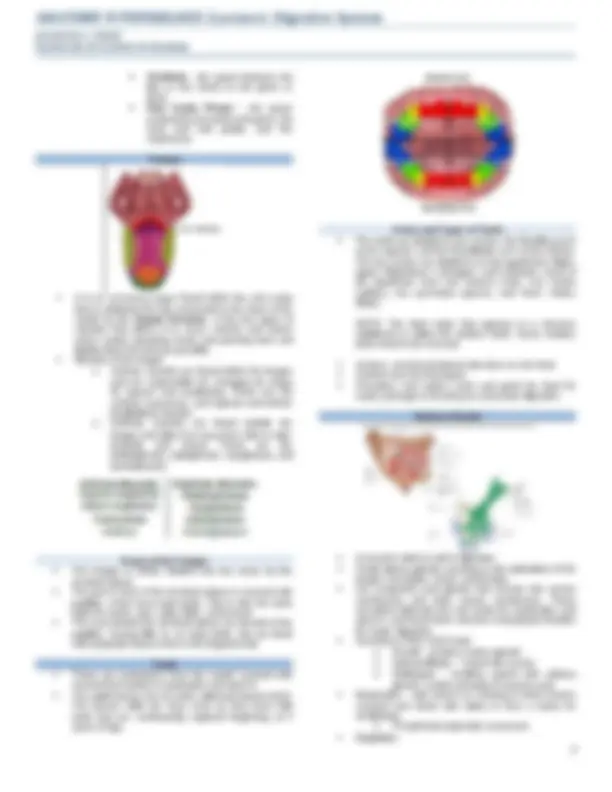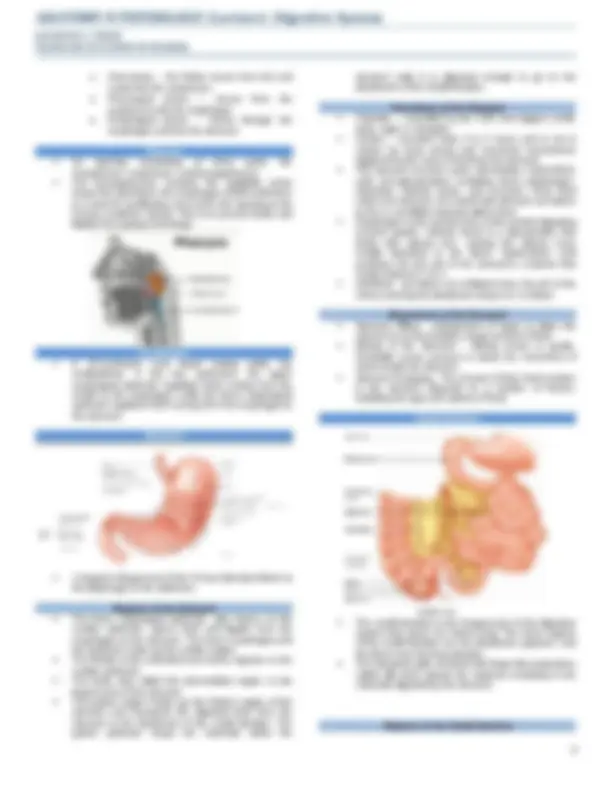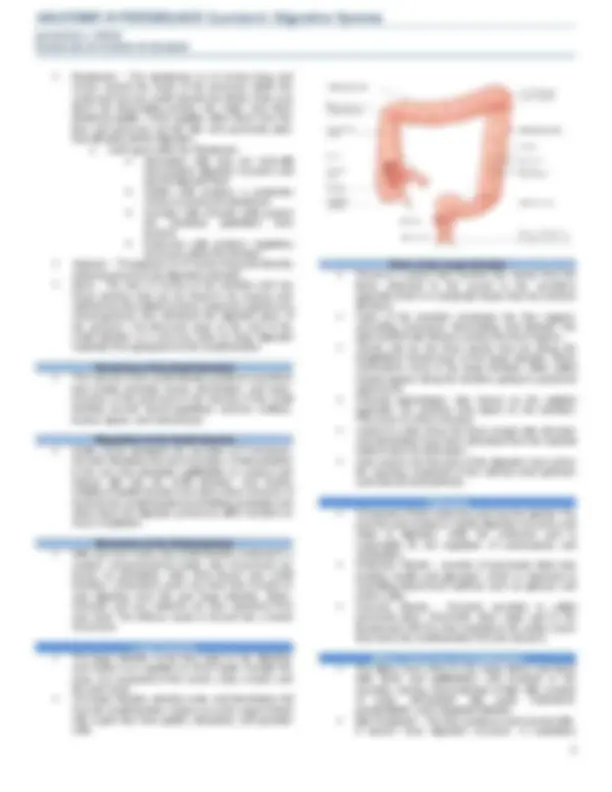





Study with the several resources on Docsity

Earn points by helping other students or get them with a premium plan


Prepare for your exams
Study with the several resources on Docsity

Earn points to download
Earn points by helping other students or get them with a premium plan
Community
Ask the community for help and clear up your study doubts
Discover the best universities in your country according to Docsity users
Free resources
Download our free guides on studying techniques, anxiety management strategies, and thesis advice from Docsity tutors
This document contains the Human Anatomy & Physiology: Digestive System.
Typology: Study notes
1 / 7

This page cannot be seen from the preview
Don't miss anything!




Digestive System The digestive system consists of a group of organs that break down the food we eat into smaller molecules that can be used by body cells. Two groups of organs compose the digestive system: gastrointestinal tract and accessory organs As fetuses, we received nutrients through the umbilical cord which connects to our mothers. After being born all important meals are taken orally and ex pelled through the anus. Digestive Processes
elements that pass through the mucosa are picked up from the blood vessels of the submucosa. It contains many blood and lymphatic vessels that receive absorbed food molecules.
o Oral phase – the Bolus moves from the oral cavity into the oropharynx. o Pharyngeal phase – moves from the oropharynx into the esophagus o Esophageal phase – moves through the esophagus and into the stomach. Pharynx An opening comprising of three parts: the nasopharynx, oropharynx, and laryngopharynx. The laryngopharynx contains the epiglottis which keeps the opening to the esophagus closed until there is a need for swallowing, from which the opening to the trachea would be closed. This is to prevent foods and liquids from going to the lungs. Esophagus A 25-centimeter tract found resting within the mediastinum. It has two sphincters: the upper esophageal sphincter regulates food coming from the mouth to the esophagus, while the lower esophageal sphincter regulates food coming from the esophagus to the stomach. Stomach J-shaped enlargement of the GI tract directly inferior to the diaphragm in the abdomen. Regions of the Stomach The lower esophageal sphincter, also known as the cardiac sphincter, opens food and liquids from the esophagus to the stomach. The lower esophagus and the sphincter make up the cardiac region. The fundus is the extended area that is superior to the cardiac sphincter. The body, also called the intermediate region, is the largest area of the stomach. The pyloric region makes up the bottom region of the stomach and transports the digested food from the stomach to the duodenum of the small intestine. The pyloric sphincter keeps the materials within the stomach until it is digested enough to go to the duodenum of the small intestine. Secretions of the Stomach Cephalic – controlled by the CNS that triggers smell, taste, sight, or thoughts. Gastric – secretion lasts 3 to 4 hours and is set in motion by local neural and hormonal mechanisms triggered by the entry of food into the stomach The stomach secretes water, electrolytes, hydrochloric acid, and glycoproteins, including mucin, pepsinogen, histamine, intrinsic factor, and enzymes. Once food enters the stomach, it is mixed with stomach secretions to form a semifluid material called chime. Pepsinogen is the inactive form of the protein-digesting enzyme pepsin. Intrinsic factor is a glycoprotein that binds with vitamin b12, making the vitamin more readily absorbed in the ileum. Hydrochloric acid produces the low pH of the stomach’s contents that ranges between 1 to 3. Intestinal - secretions are inhibited when the pH of the chime entering the duodenum drops to 2 or below Movements of the Stomach Stomach Filling - enlargement of rugae to allow the stomach to accommodate a large amount of food Mixing of the Stomach - Mixing waves is gentle. Peristaltic waves process is about the movement of chime inside the stomach. Stomach Emptying - The amount of time food remains in the stomach depends on a number of factors, including the type and volume of food. Small Intestine The small intestine is the longest part of the digestive system that spans six meters long. The three regions of the small intestine are the duodenum, jejunum, and the ileum near the long intestine. The intestinal walls are lined with finger-like projections called villi which absorb the nutrients remaining in the materials digested by the stomach. Regions of the Small Intestine
Duodenum - The duodenum is 12 inches long and curves around the head of the pancreas within the cavity and has two small mounds two-thirds of the way down the descending portion: the major and minor duodenal papilla. These papillae allow ducts from the liver and pancreas secrete bile and pancreatic juice that will aid in further digestion. o Cell Types within the Duodenum Absorptive cells that are microvilli that produce digestive enzymes and absorb digested food Goblet cells produce a protective mucus to protect the duodenum Granular cells (Paneth cells) protect the intestinal epithelium from bacteria Endocrine cells produce regulatory hormones within the intestine Jejunum - The jejunum is 3.5 inches long and absorbs nutrients present in the digested materials. Ileum - The last 2.5 inches of the intestine and has Peyer patches that can be found in its mucosa and submucosa that initiate immune responses against any microorganisms that withstood the digestive juice of the stomach. The ileocecal valve at the end of the small intestine is a one-way valve to keep digested materials from going back to the small intestine. Secretions of the Small Intestine The mucosa of the small intestine produces secretions that contain primarily mucus, electrolytes, and water. Exocrine of the pancreas in the mucosa of the small intestine secrete mucus peptidase, sucrose, maltase, lactase, lipase, and enterokinase Regulation of the Small Intestine Acidic chyme stimulates the secretion of 3 hormones: Secretin stimulates the pancreas juice, Cholecystokinin is the one that stimulates gallbladder to contract and release bile into the small intestine, and Gastric Inhibitory Peptide function is to slows down entrance of food into the small intestine by inhibiting peristalsis and slows down the digestive process to allow reactions to reach completion Movement of the Small Intestine After you eat a meal, your small intestine contracts in a random, unsynchronized matter, this movements are known as peristalsis. After food leaves your small intestine, contractions push any food that remains in your digestive tract into your large intestine. Water, minerals, and any nutrients are then absorbed from your food. The leftover waste is formed into a bowel movement. Large Intestine The large intestine is the last organ in the digestive tract before it is expelled as fecal matter through the anus. It is comprised of the cecum, colon, rectum, and the anal canal. The large intestine absorbs water and electrolytes left from the small intestine. It does so as the organ is lined with crypts that have goblet, absorptive, and granular cells. Parts of the Large Intestine Cecum is a pouch that receives the chyme from the ileum. Attached to the cecum is the vermiform appendix which is a lymphatic tissue that has immune functions. Colon of the intestine comprises the four regions: ascending, transverse, descending, and sigmoid. The right and left colic flexures section the three regions. Taenia coli are the three bands that run along the longitudinal muscle layer of the large intestine. When contractions occur in the large intestine, folds called haustra appear along the intestine, giving it a puckered appearance. Omental appendages, also known as the epiploic appendix, are pouches that attach to the intestine. They have no known function rectum is a tube where the feces remain after all water and electrolytes have been absorbed from the material until it is time for defecation. anal canal is the last part of the digestive tract and is the opening comprised of the internal anal sphincter and external anal sphincter. Pancreas Composed of both endocrine and exocrine glands. The exocrine part produces mainly digestive enzymes and helps in digestion, while the endocrine part is responsible for the regulation of carbohydrate and metabolism. Endocrine Glands - consists of pancreatic islets that produce insulin and glucagon, which is important in controlling blood level nutrients such as glucose and amino acids. Exocrine Glands - Exocrine secretion is called pancreatic juice. Pancreatic Juice major part is the bicarbonate (HCO3-) that neutralizes the acidic chyme that enters the small intestine from the stomach. Biliary Tract (Liver and Gallbladder) The biliary tract refers to the organ (liver) and ducts (bile ducts and gallbladder) and involved in the secretion, storing, and production of bile. Bile consists of water, electrolytes, bile acids, cholesterol, phospholipids, and conjugated bilirubin. Bile Production - The liver produces and secretes bile. It doesn’t have digestive enzymes. It neutralizes
down into tripeptides, dipeptides, and amino acids by peptidases bound to the microvilli of the small intestine. Lipids The liver and pancreas are important sites for lipid metabolism. Bile emulsifies fats into small particles. The small intestine and lipase from the pancreas hydrolyze fatty acids into free fatty acids and monoglycerides. These small molecules (glycerol, short-chain, medium-chain fatty acids) are absorbed into the body by the small intestine and are re-synthesized in small intestine. Then it will be re-synthesized in small intestinal cells and along with phospholipids, cholesterol, and proteins to form chylomicron, which will enter the blood circulation from lymphatic cells Water and Minerals About 9L of water can enter our digestive tract and 92% is absorbed in the small intestine, and about 6-7% is absorbed in the large intestine. Osmotic gradient determines the direction of this diffusion. When chime is dilute, it will go to the intestinal wall into the blood, and when the chime is concentrated, the water moves by osmosis into the lumen of the small intestine. Active transport in the small intestine drives the absorption of sodium, potassium, calcium, magnesium, and phosphate.